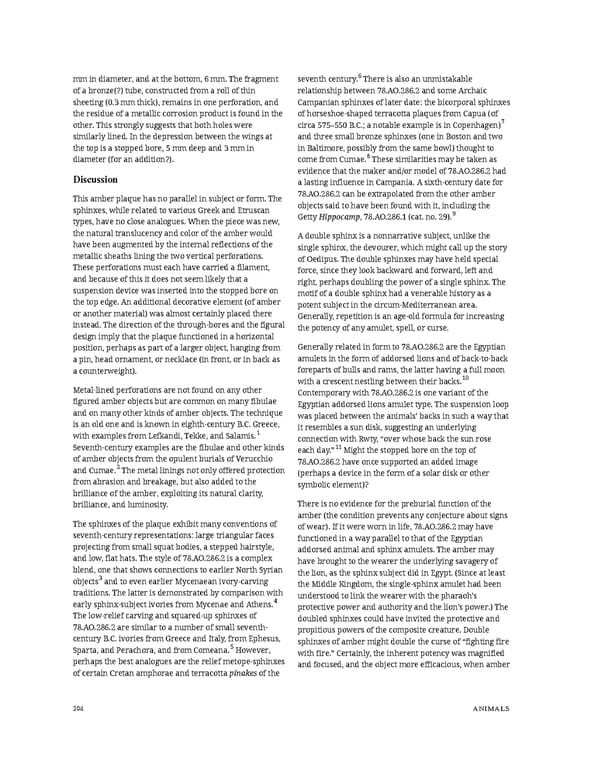mm in diameter, and at the bottom, 6 mm. The fragment seventh century.6 There is also an unmistakable of a bronze(?) tube, constructed from a roll of thin relationship between 78.AO.286.2 and some Archaic sheeting (0.3 mm thick), remains in one perforation, and Campanian sphinxes of later date: the bicorporal sphinxes the residue of a metallic corrosion product is found in the of horseshoe-shaped terracotta plaques from Capua (of other. This strongly suggests that both holes were circa 575–550 B.C.; a notable example is in Copenhagen)7 similarly lined. In the depression between the wings at and three small bronze sphinxes (one in Boston and two the top is a stopped bore, 5 mm deep and 3 mm in in Baltimore, possibly from the same bowl) thought to diameter (for an addition?). come from Cumae.8These similarities may be taken as Discussion evidence that the maker and/or model of 78.AO.286.2 had a lasting influence in Campania. A sixth-century date for This amber plaque has no parallel in subject or form. The 78.AO.286.2 can be extrapolated from the other amber sphinxes, while related to various Greek and Etruscan objects said to have been found with it, including the Getty Hippocamp,78.AO.286.1(cat. no. 29).9 types, have no close analogues. When the piece was new, the natural translucency and color of the amber would A double sphinx is a nonnarrative subject, unlike the have been augmented by the internal reflections of the single sphinx, the devourer, which might call up the story metallic sheaths lining the two vertical perforations. of Oedipus. The double sphinxes may have held special These perforations must each have carried a filament, force, since they look backward and forward, left and and because of this it does not seem likely that a right, perhaps doubling the power of a single sphinx. The suspension device was inserted into the stopped bore on motif of a double sphinx had a venerable history as a the top edge. An additional decorative element (of amber potent subject in the circum-Mediterranean area. or another material) was almost certainly placed there Generally, repetition is an age-old formula for increasing instead. The direction of the through-bores and the figural the potency of any amulet, spell, or curse. design imply that the plaque functioned in a horizontal position, perhaps as part of a larger object, hanging from Generally related in form to 78.AO.286.2 are the Egyptian a pin, head ornament, or necklace (in front, or in back as amulets in the form of addorsed lions and of back-to-back a counterweight). foreparts of bulls and rams, the latter having a full moon with a crescent nestling between their backs.10 Metal-lined perforations are not found on any other Contemporary with 78.AO.286.2 is one variant of the figured amber objects but are common on many fibulae Egyptian addorsed lions amulet type. The suspension loop and on many other kinds of amber objects. The technique was placed between the animals’ backs in such a way that is an old one and is known in eighth-century B.C. Greece, it resembles a sun disk, suggesting an underlying with examples from Lefkandi, Tekke, and Salamis.1 connection with Rwty, “over whose back the sun rose Seventh-century examples are the fibulae and other kinds each day.”11 Might the stopped bore on the top of of amber objects from the opulent burials of Verucchio 78.AO.286.2 have once supported an added image and Cumae.2The metal linings not only offered protection (perhaps a device in the form of a solar disk or other from abrasion and breakage, but also added to the symbolic element)? brilliance of the amber, exploiting its natural clarity, brilliance, and luminosity. There is no evidence for the preburial function of the amber (the condition prevents any conjecture about signs The sphinxes of the plaque exhibit many conventions of of wear). If it were worn in life, 78.AO.286.2 may have seventh-century representations: large triangular faces functioned in a way parallel to that of the Egyptian projecting from small squat bodies, a stepped hairstyle, addorsed animal and sphinx amulets. The amber may and low, flat hats. The style of 78.AO.286.2 is a complex have brought to the wearer the underlying savagery of blend, one that shows connections to earlier North Syrian the lion, as the sphinx subject did in Egypt. (Since at least objects3 and to even earlier Mycenaean ivory-carving the Middle Kingdom, the single-sphinx amulet had been traditions. The latter is demonstrated by comparison with understood to link the wearer with the pharaoh’s early sphinx-subject ivories from Mycenae and Athens.4 protective power and authority and the lion’s power.) The The low-relief carving and squared-up sphinxes of doubled sphinxes could have invited the protective and 78.AO.286.2 are similar to a number of small seventh- propitious powers of the composite creature. Double century B.C. ivories from Greece and Italy, from Ephesus, sphinxes of amber might double the curse of “fighting fire Sparta, and Perachora, and from Comeana.5 However, with fire.” Certainly, the inherent potency was magnified perhaps the best analogues are the relief metope-sphinxes and focused, and the object more efficacious, when amber of certain Cretan amphorae and terracotta pinakes of the 204 ANIMALS
 Ancient Carved Ambers in the J. Paul Getty Museum Page 213 Page 215
Ancient Carved Ambers in the J. Paul Getty Museum Page 213 Page 215